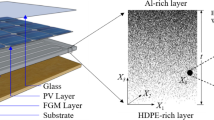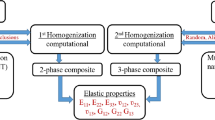Abstract
This contribution describes a scale bridging approach for modelling pressure independent elastoplastic unidirectional metallic composite materials by making use of an anisotropic elastoplastic constitutive model. The material under investigation is tungsten fiber reinforced copper (W/Cu) composite. To identify the yield surface of the composite, a finite element model of a repeating unit cell (RUC) is set-up (micro-model). Through virtual experiments, the yield surface of the composite is identified. An anisotropic elastoplastic constitutive model based on the identified yield surface, which makes use of the concept of structural tensors, is developed. This material model serves as the material model for macro computations. To ensure a good agreement between constitutive model and RUC during plastic evolution, multiple hardening functions are employed. The parameters of the constitutive model are identified and the constitutive model is validated against the response of the RUC.
Similar content being viewed by others
References
Doychak, J.: Metal- and intermettallic-matrix composites for aerospace propulsion and power systems. J. Min. Met. Mat. S. 44, 46–51 (1992)
Sanfeliz, J.G.: Elastic-plastic finite element analyses of a unidirectional, 9 vol % tungsten fiber reinforced copper matrix composite. Nasa Technical Memorandum 106304. NASA (1993)
Miehe, C., Schotte, J., Schröder, J.: Computational micro-macro transitions and overall moduli in the analysis of polycrystals at large strains. Comput. Mater. Sci. 16, 372–382 (1999)
Kanouté, P., Boso, B.P., Chaboche, J.L., Schrefler, B.A.: Multiscale methods for composites: a review. Arch. Comput. Meth. Eng. 16, 31–37 (2009)
Geers, M.G.D., Kouznetsova, V.G., Brekelmans, W.A.M.: Multi-scale computational homogenization: trends and challenges. J. Comput. Appl. Math 234, 2175–2182 (2010)
Reese, S.: Meso-macro modelling of fiber-reinforced rubber-like composites exhibiting large elastoplastic deformation. Int. J. Solids Struct. 40, 951–980 (2003)
Stier, B., Simon, J.W., Reese, S.: Finite element analysis of layered fiber composite structures accounting for the materials microstructure and delamination. Appl. Compos. Mater. 21, 1–17 (2014)
Simon, J.W., Höwer, D., Stier, B., Reese, S.: Meso-mechanically motivated modeling of layered fiber reinforced composites accounting for delamination. Compos. Struct. 122, 477–487 (2015)
Gaser, T.C., Holzapfel, G.A.: A rate-independent elastoplastic constitutive model for biological fiber-reinforced composites at finite strains: continuum basis, algorithmic formulation and finite element implementation. Comput. Mech. 29, 340–360 (2002)
Vladimirov, I.N., Pietryga, M.P., Reese, S.: Anisotropic finite elastoplasticity with nonlinear kinematic and isotropic hardening and application to sheet metal forming. Int. J. Plast. 26, 659–687 (2010)
Vogler, V., Rolfes, R., Camanho, P.P.: Modelling the inelastic deformation and fracture of polymer composites—part I: plasticity model. Adv. Appl. Mech. 59, 50–64 (2013)
Svendsen, B., Levkovitch, V., Wang, J., Reusch, F., Reese, S.: Application of the concept of evolving structural tensors to the modelling of initial and induced anisotropy at large deformation. Comput. Struct. 84, 1077–1085 (2006)
Noman, M., Clausmeyer, T., Barthel, C., Svendsen, B., Huétink, J., van Riel, M.: Experimental characterization and modeling of the hardening behavior of the sheet steel LH800. Mater. Sci. Eng. A 527, 2515–2526 (2010)
Pietryga, M.P., Vladimirov, I.N., Reese, S.: A finite deformation model for evolving flow anisotropy with distorsional hardening including experimental validation. Mech. Mater. 44, 163–173 (2012)
Abaqus finite element software: Dessault systémes. Providence, RI (2015)
Barbero, E.J.: Finite Element Analysis of Composite Materials using Abaqus. CRC Press (2008)
Chaboche, J.L.: A review of some plasticity and viscoplasticity constitutive theories. Int. J. Plast. 24, 1642–1693 (2008)
Hill, R.: A theory of the yielding and plastic flow of anisotropic metals. Proc. R. Soc. London, Ser. A 193, 95–102 (1948)
Spencer, A.J.M.: Theory of invariants. In: Continuum Physics. Academic Press, New York (1971)
Boehler, J.P.: A simple derivation of representations for non-polynomial constitutive equations in some cases of anisotropy. Z. Angew. Math. Mech. 59, 157–167 (1979)
Zhang, J.M., Rychlewski, J.: Structural tensors for anisotropic solids. Arch. Mech. 42, 267–277 (1990)
Vladimirov, I.N., Pietryga, M.P., Reese, S.: On the influence of kinematic hardening on plastic anisotropy in the context of finite strain plasticity. Int. J. Mater. Form. 4, 255–267 (2011)
Reese, S., Raible, T., Wriggers, P.: Finite element modelling of orthotropic material behaviour in pneumatic membranes. Int. J. Solids Struct. 38, 9525–9544 (2001)
Acknowledgements
The authors gratefully acknowledge the financial support from the Deutsche Forschungsgemeinschaft through Grant GSC 111. The last author is grateful for the financial support provided by the Ministry of Innovation, Science and Research of the State of North Rhine-Westphalia. The authors would also like to acknowledge Dipl.-Ing. Bertram Stier for providing the finite element model of the unidirectional composite repeating unit cell (RUC) used in this work.
Author information
Authors and Affiliations
Corresponding author
Editor information
Editors and Affiliations
Rights and permissions
Copyright information
© 2018 Springer International Publishing AG
About this chapter
Cite this chapter
Bedzra, R., Reese, S., Simon, JW. (2018). Micro-Macro Modelling of Metallic Composites. In: Sorić, J., Wriggers, P., Allix, O. (eds) Multiscale Modeling of Heterogeneous Structures. Lecture Notes in Applied and Computational Mechanics, vol 86. Springer, Cham. https://doi.org/10.1007/978-3-319-65463-8_2
Download citation
DOI: https://doi.org/10.1007/978-3-319-65463-8_2
Published:
Publisher Name: Springer, Cham
Print ISBN: 978-3-319-65462-1
Online ISBN: 978-3-319-65463-8
eBook Packages: EngineeringEngineering (R0)




